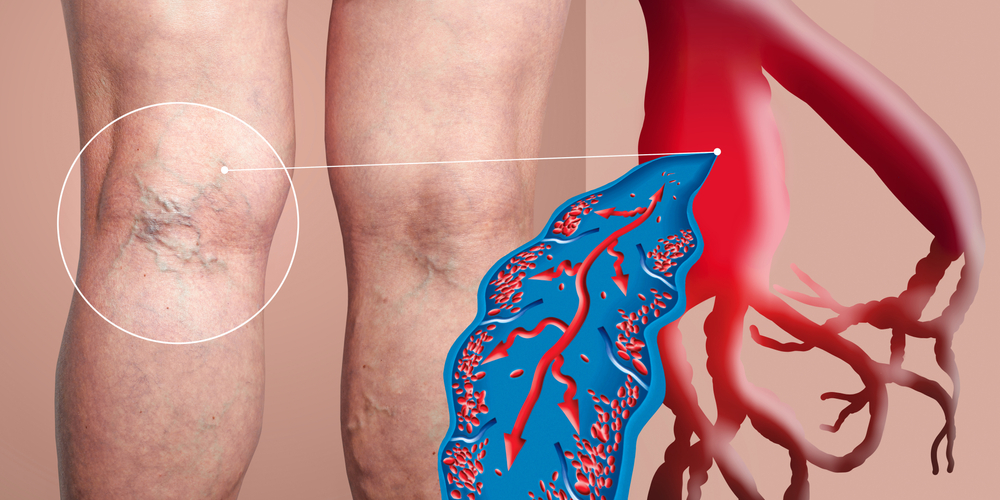Deep vein thrombosis (DVT) is when a blood clot forms in a deep vein, typically occurring in the legs. The clot can cause pain, swelling, or no symptoms at all. While a DVT isn’t always life-threatening, it’s essential to receive medical treatment as soon as possible to prevent any complications.
Deep Vein Thrombosis (DVT) Explained
A blood clot in the leg occurs when veins in the legs are injured, or blood is not flowing properly through them. DVTs are most common in the legs, but they can also occur in other parts of the body, such as the arm, kidney, intestines, or liver.
The blood clot will partially or completely block healthy blood flow through that vein. It can also damage the valves, causing leaky veins and scarring that prevents the veins from working properly.
Blood clots in the leg can become serious, as the clot has the potential to break off and travel to other parts of the body.. This is particularly dangerous if the clot gets stuck in the lungs. When a blood clot blocks the blood flow to the lungs, it can cause a medical emergency known as a pulmonary embolism. [1]
Recognizing the Symptoms of Deep Vein Thrombosis
To avoid a medical emergency caused by a blood clot, be aware of the deep vein thrombosis symptoms to look out for. Let’s start with some of the signs of a blood clot in the leg:[2]
- Swelling of just one leg, as typically a clot only happens in one leg, not both
- Throbbing pain in one leg, which is typically worse when standing or walking
- Warmness in the painful area of the leg
- Swollen, hard veins that are painful to the touch
- Red or dark-colored skin in the painful area
If the DVT is in another part of the body, you may experience similar symptoms wherever the clot is located. You may have severe stomach pain if the clot is in the abdomen. If the clot has reached the lungs, you may have trouble breathing or chest pain.
Risk Factors for Developing DVT
Several risk factors may predispose you to have a blood clot in the leg or other parts of the body. These include:[3]
- Having had a DVT before
- Being overweight
- Being over 60 years old
- Smoking
- Having varicose veins
- Taking the birth control pill or HRT
- Pregnancy or have recently given birth
- Family history of DVT
- Genetic conditions
- Medical conditions like cancer, bowel disease, or heart failure
- Staying confined to a bed, especially after being in the hospital or having surgery
- Going on a trip for more than three hours in an airplane, train, or car
- Vein injury
- Dehydration
Now that you know some of the causes of a DVT, if you’re at risk, be sure to speak to your doctor about prevention measures you can take.
Treatment and Management of Deep Vein Thrombosis
If you suspect you have a DVT, the first step is to seek medical care immediately for an ultrasound of the affected area. The first treatment is a blood-thinning medication, such as Eliquis. You will likely be prescribed this medication for three to six months. Wearing compression stockings for a period of time may be recommended for improved blood flow. Depending on the location and size of the blood clot, surgery or other procedures may be recommended to remove the clot.
The goal of any treatment for deep vein thrombosis is to lower the risk of complications and prevent the DVT from happening again. But, even with the right treatment, it’s important to know that it can take time for the DVT to dissolve. You will need to keep up with the medication and compression therapy for several months to complete the treatment and resolve the clot.
Preventing DVT: Steps You Can Take
If you are at risk for a DVT or have had a DVT in the past, there are many things you can do to prevent them from happening again, including:
- Staying physically active
- Avoiding sitting for long periods
- Keeping your legs elevated when sitting
- Wearing compression stockings, particularly if sitting or standing for long periods
- Maintaining a healthy weight
- Not smoking and limiting alcohol intake
- Taking any medication as directed by your doctor
Having untreated varicose veins can increase your risk for DVT. At Empire Vein & Vascular Specialists, we can help lower this risk and address any vein-related concerns you might have. Our offices throughout Southern California offer several non-invasive procedures, including VenaSeal™, that can help give you long-term relief.
To get started with a free consultation, contact Empire Vein & Vascular Specialists today by calling 1-800-827-4267 or booking online. Our expert team is here to help you feel better and lower your risk for DVT.
References:
- https://www.cdc.gov/ncbddd/dvt/facts.html
- https://www.cdc.gov/ncbddd/dvt/infographic-risk.html
- McLendon, K., Goyal, A., & Attia, M. (2023). Deep Venous Thrombosis Risk Factors. StatPearls Publishing.
- Waheed, S. M., Kudaravalli, P., & Hotwagner, D. T. (2023). Deep Vein Thrombosis. StatPearls Publishing.
